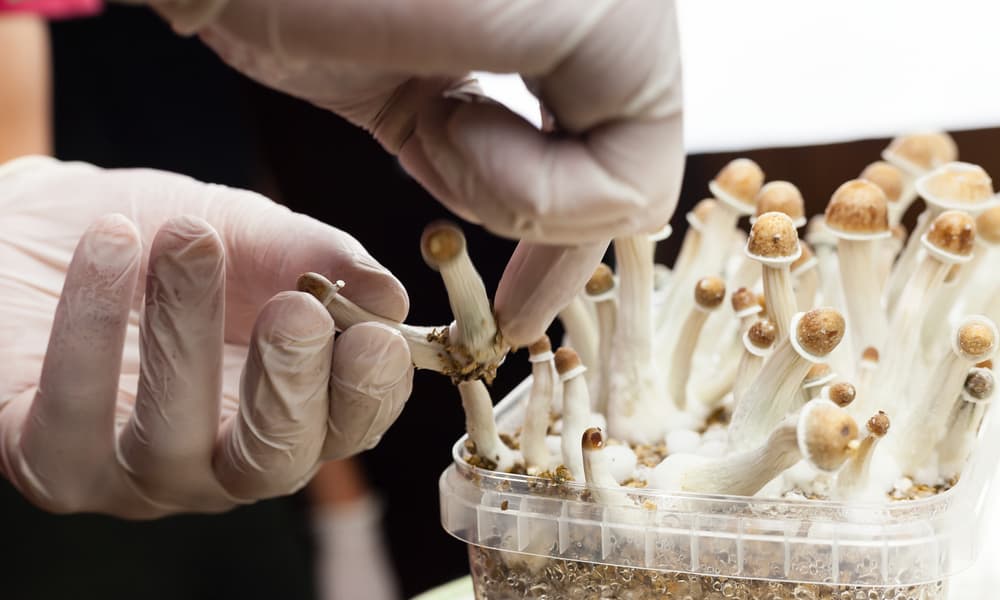Researchers At Miami University Produce Psilocybin From E. coli Bacteria
FeaturedTrending Stories October 3, 2019 MJ Shareholders 0

Forget going through the trouble of growing mushrooms. Researchers at Miami University in Oxford, Ohio have figured out a way to mass produce psilocybin using bacteria. And they say they’re yielding quantities of the therapeutic compound that would otherwise require some serious square footage, not to mention many months, to yield from mushrooms. But this isn’t a synthetic or artificial process. Instead, the team of researchers—undergraduates led by assistant professor Andrew Jones—turned to a common laboratory method: splicing DNA.
After isolating the DNA sequence behind the production of psilocybin in mushrooms, the team did a simple copy/paste, splicing the mushroom DNA into the genome of E. coli. Then, they sat back and watched the E. coli work its mushroom magic, following the DNA’s instructions to produce psilocybin.
Scientists Are Working Technology to Mass Produce Psilocybin
“Once we transferred the DNA, we saw a tiny peak emerge in our data,” said Alexandra Adams, a junior chemical engineering major and lead author of the study presenting the groundbreaking work. “We knew we had done something huge.”
And something out of a sci-fi novel, too. By imbuing the humble E. coli bacterium with the psilocybin-producing power of a fungus, the researchers made the jump between two completely distinct domains of life. They may also have developed a method for producing psilocybin that overcomes the natural limitations of cultivating mushrooms and the exorbitant expense of synthetic chemical production methods.
Genetically engineering E. coli to make psilocybin was only half of the puzzle, however. The other half was figuring out how to kick the E. coli into overdrive so that it didn’t just produce psilocybin, but produced a ton of it. That took several months of experimenting, and the team is still tweaking the setup to find the optimal conditions for E. coli to produce the compound.
How optimal? The newly-published study, which appears in Metabolic Engineering, says the experiments are now yielding gram-scale production—1.16 grams per liter, to be exact. “Over the course of this study we improved production from only a few milligrams per liter to over a gram per liter, a near 500-fold increase,” said Jones. With that kind of speed and scale it’s possible to conceive of a future with legal and economically mass-produced psilocybin.
Chemical Engineers Eyeing Future for Psilocybin-based Medicines
Psychedelic mushrooms, plants, and cacti, or more specifically, the compounds in them—DMT, psilocybin, mescaline—are gaining increasing recognition and legitimacy as therapeutic, medicinal substances. There are currently a number of clinical trials underway to investigate the potential use for psychedelic compounds in the treatment of addiction, depression, post-traumatic stress disorder and other mental health conditions. Recent studies have shown how therapeutic doses of psychedelic substances can heal and regenerate brain tissue and help treat mental illness. Other studies show how psychedelics can help with wean people off of highly addictive drugs.
Researchers are likewise turning their attention to the ways psychedelic experiences expand consciousness and improve mental health. Indeed, the use of psychedelics dates back millennia, and they have been central to the spiritual and healing practices of many cultures. Now that more medical professionals are beginning to take psychedelics seriously, chemical engineers and research scientists are getting to work unlocking their vast potential for human health and wellness.
MJ Shareholders
MJShareholders.com is the largest dedicated financial network and leading corporate communications firm serving the legal cannabis industry. Our network aims to connect public marijuana companies with these focused cannabis audiences across the US and Canada that are critical for growth: Short and long term cannabis investors Active funding sources Mainstream media Business leaders Cannabis consumers











No comments so far.
Be first to leave comment below.